Coronavirus, COVID-19, MERC, SARS are the most frequently appearing words recently in the context of the second wave of the pandemic. At such moments, it is worth learning from the past and following the causes of the most deadly epidemics in history.
The virus attacked in two waves. The first began in the spring of 1918, when over 110,000 American troops were deployed to the European front. It was three and a half years after Great Britain and France declared war on Germany and Austria-Hungary. The fighting has now spread to all of Europe. President Woodrow Wilson announced in 1914 that the United States would pursue a policy of "strict neutrality", but this soon proved increasingly difficult to maintain as German submarines attacked the American navy.
Flu in the barracks
Since 1917, the United States military has sent masses of young men across the Atlantic to large, overcrowded military camps that have provided an excellent environment for the development of the flu virus. In the summer of 1918, the cramped conditions in the barracks became fatal. The mutant virus turned out to be especially dangerous for people at a young age. The soldiers lay side by side in the enormous sick rooms, separated only by the hanging sheet.
This may explain why far more soldiers died than civilians, although the number of cases was the same. Most of the seriously ill soldiers were placed in overcrowded rooms, where they spread bacteria that caused tragic secondary infections. Instead of restoring patients to health, the infirmary used germs like huge petri dishes. The virus was not limited to barracks and field hospitals. Throughout Europe, tens of thousands of people have wandered back and forth between home, military base, docks and the fighting front. The US Department of War sent 200,000 troops to France each month. By March, over a million Americans were fighting in Europe.
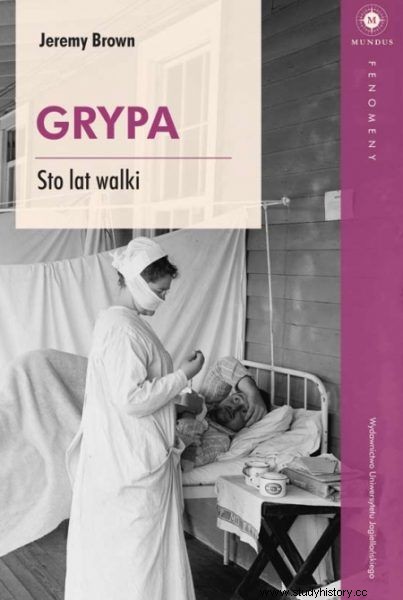
The article is an excerpt from the book Flu. One hundred years of struggle Publishing House of the Jagiellonian University.
We don't know how many civilians fell ill and died during the first wave. In those days, doctors were not required to report flu information. State and regional health service administration institutions were sparse, and the existing ones were often poorly managed. However, we can get some insight by looking at military statistics.
Beginning in March 1918, there was a sudden increase in flu cases at the Camp Funston base in Kansas. Most of the soldiers recovered after two or three days of bed rest and taking aspirin, but 200 developed pneumonia and about 60 died. In the huge garrison with 42,000 people, these numbers did not impress the military doctors.
The situation in Europe was more dramatic. One of the medical officers wrote that the flu was raging in his division and that the soldiers were not able to march. By spring, 90 percent of the US Army's 168th Infantry Regiment had fallen ill. By June 1918, the disease had spread to French and British troops. In the UK, over 31,000 cases of influenza have been reported among soldiers, representing a six-fold increase compared to the previous month. On the European continent, over 200,000 British soldiers were unable to report combat readiness. The virus continued to travel, mostly by sea. He attacked Freetown, Sierra Leone, following the arrival of a British steamer on which more than 200 crew members had or had had flu a little earlier. In less than a week, the virus spread across the country; even before the end of September, two thirds of the population became infected with it, and 3 percent died. A flu outbreak has also been reported in Mumbai. In Shanghai. In New Zealand.
Second Wave
The first wave was mild. Although many fell ill, the flu only lasted two or three days and almost all recovered. As usual, the disease was the greatest risk for the youngest and the oldest, and the mortality in these groups was much higher than in the overall population. Epidemiologists who analyzed death statistics, however, saw increased mortality among the population between these extreme age groups. It was extremely common for young adults to die of influenza.
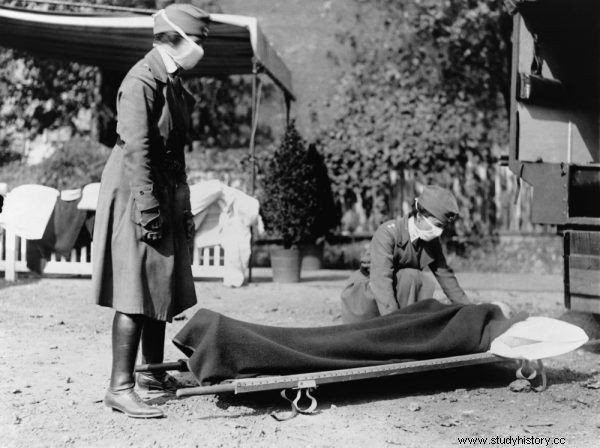
The flu spread very quickly. Two nurses during the influenza pandemic (1918) are shown.
In a chart showing the relationship between age and flu mortality, we usually see a U-shaped curve with one arm representing the youngest and the other the oldest. In the midst of fatalities, there are very few. The graph showing the flu deaths in early 1918 is W shaped. The greatest death rate is still at both ends of the curve, but there is an extra spike in the young adult group. The group of twenty-one to twenty-nine years of age, usually considered the least likely to die from an infectious disease, is the most numerous. This was what caused the surprise and the anxiety.
By the time the first wave of influenza hit the European continent, it was almost completely extinct in the United States. Finally, the number of cases has also decreased in Europe. In June 1918, the British Medical Journal reported that flu was no longer a threat. On both sides of the Atlantic, however, the worst was yet to come.
The virus may have mutated into a more dangerous form. Perhaps in the fall, people lived in larger groups, which was conducive to infection. Anyway, a new wave of flu has started.
Among the earliest reports of the Second Wave was that of Camp Devens, located less than thirty miles west of Boston. More than 45,000 were now stationed in the barracks for 36,000 soldiers. The flu broke out on September 8 and was spreading rapidly. 90 patients came to the infirmary during the day. After that, five hundred a day. Finally 1000 hit by the flu every day. The hospital was huge, it could accommodate up to 1,200 patients, but soon it turned out to be too small. After all, there were 6,000 flu victims. Bed by the bed. Row after row.
"We eat it, we live it, we sleep with it and we dream about it, let alone breathe it for 16 hours a day," wrote the young paramedic in a letter dated September 29, 1918. He was assigned to a room with 150 men, and the only clue as to his identity was Roy's name. Nobody could think of anything but the flu. One of the long barracks was turned into a morgue, where deceased soldiers dressed in uniforms were stacked in double rows. The corpses were taken away on special trains. There were no coffins for several days and, as reported by Roy, bodies piled "gruesome". As a witness to countless deaths, he described what happened to the victims of the disease. Though its onset resembled a normal case of influenza, the infection rapidly developed into "the most virulent type of pneumonia ever seen." About a hundred people died at the base every day. Among them was the "horrendous" number of nurses and doctors. "This is not even comparable to what happened in France after the battle," wrote Roy. Although he was familiar with the devastation and chaos of the great war, the flu turned out to be something much worse.
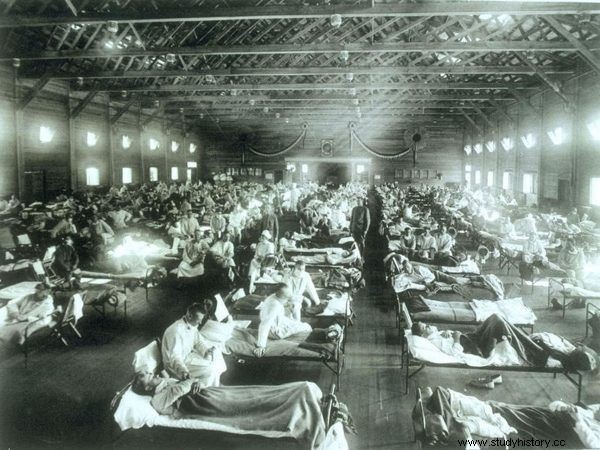
The Spanish flu struck during the First World War. Pictured is Fort Riley, Kansas (USA) First Aid.
We also know about the nightmare at Camp Devens from another eyewitness, Victor C. Vaughan, a distinguished physician and dean of the University of Michigan medical faculty. In his diary, he recalled ghostly images still in his mind:"I would like to tear them out and destroy them if I could, but it is beyond my strength." One of these memories is about the Camp Devens ward hospital. He wrote:
I saw hundreds of young, burly men in their country's uniform come to the infirmary in groups of ten or more. They were placed on their bunks until they were all occupied, while others were pouring in. Their faces soon turned a bluish hue; coughing horribly, they spat out blood. In the morning, the dead bodies were piled up at the morgue like logs of wood.
Vaughan felt his littleness towards the plague for which he had no way. "Deadly influenza," he concluded, "has exposed the weakness of human intervention to the destruction of human life."
In less than a month, 14,000 people fell ill at Camp Devens and 750 died. The disease spread to other bases:Camp Dix, New Jersey, Camp Funston, Kansas. Military bases in California and Georgia. Nearly 500 soldiers died in Camp Upton, New York. The flu came to Camp Dodge, Iowa, from two soldiers who arrived on September 12. After six weeks, more than 12,000 people were infected at the base. At one point, there were over 8,000 soldiers in the hospital, which was four times its maximum capacity.
The course of the epidemic was similar in each base. This started with a few cases not different from the usual seasonal flu. Within a few days, the number of cases rose sharply, reaching hundreds, sometimes thousands. For three weeks, the field hospital was overcrowded and death took a heavy toll. After five or six weeks, the epidemic was dying out as mysteriously as it had started. Some people had pneumonia but no new cases and life was slowly returning to normal.
We know a lot about the flu in military bases from compulsory reports drawn up in the army. But the second wave struck outside the army, killing tens of thousands of urban and rural residents across the United States. This wave is harder to summarize; however, it is known that 675,000 civilians and military personnel died from influenza in the US by the end of the epidemic in late spring 1919. The number alone is not easy to comprehend, and the extent of the disease is almost beyond imagination. The flu has hit almost all localities.
Pandemic
In 1918, Philadelphia had over 1.7 million inhabitants. As in most developing cities at the beginning of the 20th century, they lived mostly in overcrowded tenement houses. They were particularly vulnerable to the flu, since most Philadelphia doctors and nurses were overseas dealing with the victims of the war. When the epidemic broke out, only a handful of specialists remained in the big city area. They were not prepared for what was to come.
The flu most likely hit Philadelphia in mid-September 1918, and newspapers at the time reported that the virus had made its way from the barracks into the civilian neighborhood. Rumors that the disease had been caused by germ-laden German submarines spread just as quickly. They had nothing to do with it, but the Philadelphia Naval Shipyard certainly did.
With a crew of 45,000 seamen, the shipyard has become the largest naval base in the United States. On September 7, 1918, she welcomed 300 new sailors from Boston. It can be assumed that several of them were infected with the influenza virus. Two weeks later, more than 900 sailors were sick. Superiors maintained that there was no need to worry. The germ was, in their opinion, nothing more than a regular seasonal virus, disguised under a new name.
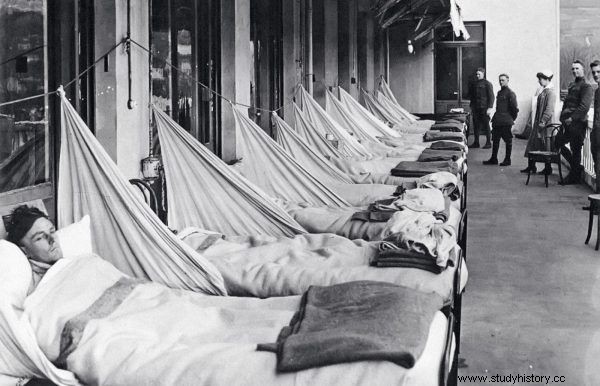
The epidemic was spreading at an alarming rate
Meanwhile, the virus was gearing up for a huge jump on civilians, and government bonds were partly to blame. As early as April 1918, a great parade was held in New York to promote war bonds, known as Liberty Bonds. Movie star Douglas Fairbanks spoke to the crowd of participants standing shoulder to shoulder. Handsome and full of personal charm, he encouraged people to buy bonds to support the war effort. Five months later, it's time for Philadelphia to kick in. On Sunday, September 28, the city has scheduled an event to kick off the fourth Liberty Bonds campaign. 3,000 brave men and "brave women when the need arises," wrote the Philadelphia Inquirer. Hundreds of factory workers were to join them, as well as the parade marshals responsible for singing together. It was all organized during the flu epidemic raging in the city. There was no concern that a large gathering could spread the disease, fears receded in the face of patriotic enthusiasm.
The parade to buy bonds turned out to be a winning march for the influenza virus. Sailors were dragging down Broad Street to the cheers of the great crowd.
"This is an incredibly impressive parade," proclaimed the Inquirer, who calculated that over 100,000 people ran into the streets. When they craned their necks to see better, they passed the virus to those around them. The March to Freedom first of all released the virus.
Just two days after the great parade, more than 100 people died of the flu every 24 hours. In a short time, this number increased sixfold. Every day, health officials announced that the epidemic was subsiding, and so were the increasingly dismal statistics. The director of the Philadelphia Department of Public Health, Dr. William Krusen has ordered the closure of schools, churches, and theaters. It seems that if he had forbidden the parade, such a dangerous situation would not have happened. The posters reminded that it was forbidden to spit in the streets. It didn't help much. On one day only, 60 spittoons were stopped.
With such a number of cases, courts and city offices were closed, and other important services struggled with the lack of staff. The police and fire brigades had to cope with the reduced staff. Faced with serious staff shortages, Pennsylvania-based Bell Telephone Company said it would only handle calls "strictly necessary due to an epidemic or hostilities." An emergency hospital was opened in the city due to overcrowding of existing hospitals. In one day, its 500 beds were occupied. Krusen called for peace and not to panic over the exaggerated reports, but Philadelphia was shaken by what appeared to be a biblical plague. Why not panic in such a situation?
The only public morgue in the city could house 36 dead. Soon there were hundreds of corpses, mostly covered only with bloody sheets. There were 10 bodies waiting for each available coffin. The stench of death was everywhere. The local carpenters abandoned their usual activities and only made coffins the whole time. Some funeral directors have increased their fees by more than 600 percent, which has forced the city to cut insurance premiums to "only" 20 percent.
The death toll in Philadelphia peaked around mid-October, and then, almost as suddenly as it had appeared, the plague was gone. It should be noted that flu continued to happen, but the deaths from it had returned to normal levels. The city was slowly regaining its old healthy identity.
What happened in Philadelphia was repeated throughout the United States and throughout the world. In San Francisco, the epidemic also peaked in October. More than 1,000 people have died this month, almost as many as normal. The flu reached Juneau, Alaska, where attempts were made to prevent the spread of the disease through quarantine orders. The governor ordered that all disembarking passengers of the ships be examined by port doctors. Anyone with flu symptoms was denied entry to Juneau. However, this did not prevent the influx of healthy-looking people who carried the virus within them without showing symptoms yet. These carriers left Seattle and arrived in Juneau a few days later, while the flu was still breeding. Upon their arrival, they were briefly examined by the doctor waiting for them, who, seeing no signs of illness, allowed them to go ashore.
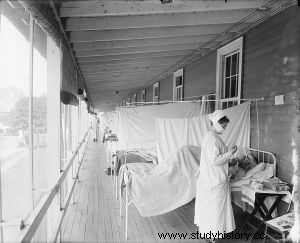
The patients were not isolated for a long time
This is probably how the virus crept into Juneau. From there, it spread to the indigenous peoples of Nome and Barrow, and to several remote villages. The ravages of the locals were even greater than elsewhere. Indigenous peoples, naturally isolated from the rest of the population, never developed anti-flu antibodies. During the 1918 pandemic, half the population of Wales, an original town of 300 inhabitants in the western tip of Alaska, died . In the Brevig Mission settlement of 80 people, only 8 survived.
The Arctic Circle horror would later help fight the virus. The dead were buried in the icy ground, and the resting place in permafrost preserved the corpse.
Eighty years later, this enabled researchers to extract samples of the virus from 1918 and identify its genetic code for the first time. For now, however, the bodies had to remain frozen in the ground and in time.
America was now waging two wars. One against Germany and its military allies, the other against the influenza virus and its bacterial allies. Let us quote the words of one historian - America's enemies are germs and Germans.
While the Allies were preparing a massive offensive on the Western Front, the flu attacked the ships carrying soldiers to European battlefields. She died in the ranks of the American Expeditionary Force at the height of the Battle of the Argentine Forest in northeastern France. Like a great war that engulfed almost every country in Europe, the flu raged across the continent. At one French military base, out of 1,000 recruits, 688 were hospitalized and 49 died. Schools were closed in Paris, but theaters and restaurants were operating. The cafes were still open when 4,000 Parisians died. The flu was going through the lines of the trenches. The Germans also suffered. "It was hard to hear the chiefs of staff report the number of flu cases every morning and regret the weakness of our soldiers in the face of the possibility of another attack by the English," wrote one of the German commanders at the time.
Keep calm and do your job
There was a mood in Britain that could be summed up by the words "keep calm and do your thing". I was born and raised in London and although I have spent most of my life outside the UK, I can recognize this attitude. Self-control and a stony face in the face of adversity is something I have known since childhood. I saw how calmly on her face my grandmother spoke about the evacuation from London during the Blitzkrieg, and I saw the same attitude to the Spanish epidemic a generation earlier. "Keep calm and do your own thing" is not only a propaganda slogan, but a component of the cultural DNA of the British.
At first, there was hardly any mention of the flu in the newspapers, and if anything, it was hidden on the inside pages. The British government and the sympathetic press have adopted a common tactic of restricting influenza information so as not to depress a society already tormented by the world war entering its fourth year. The tension between the need to report facts and the maintenance of morale is reflected in Dr. J. Oscar's letter pressed to the back of the British Medical Journal.
Aren't we going through some pretty gloomy days in which every man, woman, and child mourns a loved one? - he wrote. - Wouldn't it be better to be a little more prudent in publishing such reports instead of collecting as many black clouds as possible to spoil our breakfast? It seems that some editors and correspondents are in dire need of leave, and the sooner they take it, the better it is for public morality [sic].
Ironically, the cover page of the same issue reprinted a five-page flu report detailing the catastrophic effects of the pandemic. It has been written about the fatal wave of disease among British and French soldiers, which felled entire brigades and rendered them incapable of action.
It seems that the country's chief physician, too, was reluctant to spoil someone's breakfast. He gave sparing tips to wear facial masks, eat well and drink half a bottle of light wine. The Royal College of Physicians took a similar stance and assured that the virus was by no means more dangerous than usual. The British seemed unfazed by the course of events. In December 1918, as the pandemic was over, the London Times commented that "never since the Black Death had a plague like this raged before the eyes of the world, but perhaps never before had a plague been received with such stoic calm."
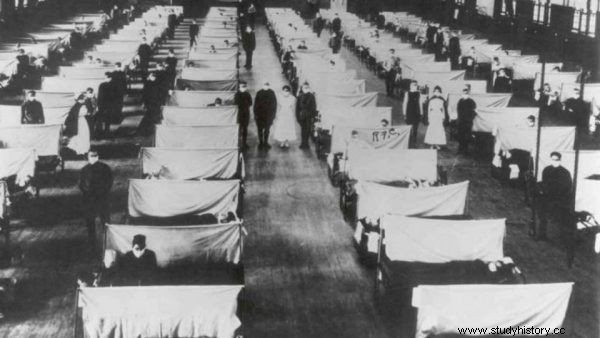
The Spaniard took a bloodier toll than World War I
Earlier that year, the medical correspondent of the Times wrote - undoubtedly exaggerating - about people who "welcomed" the outbreak of the epidemic. Historian Mark Honigsbaum believes that this British Stoicism was deliberately fueled by authorities who previously tried to instill public contempt for the German enemy. The flu outbreak was now treated with the same contempt.
Regardless of the attitude of the British, however, the toll of the pandemic was enormous. By the time it ended, a quarter of the population had been infected. Over 225,000 people died. In India, still British territory, the flu proved more lethal, with the death rate exceeding the Empire's average of 10 percent. Among Hindu soldiers, he was twice as tall. In total, approximately 20 million Indians have died as a result of the flu pandemic.
And then there was Australia and New Zealand, Spain and Japan, and African countries. They all suffered, leaving us with alarming, almost apocalyptic statistics:a total of 50 to 100 million deaths worldwide. After these mass deaths, when public opinion focused on the "how?" and "how much", scientists wondered "why?".
Is it the virus itself - maybe some influenza superversion - or were there other causes of the fatal course of the disease? We have four different explanations for why so many deaths have occurred. There is some evidence for each theory, but none is entirely satisfactory.
The first hypothesis is that there is a protein on the surface of the virus that prevents the production of interferons that signal the immune system to interfere with the body's defenses. Healthy lung cells that transport oxygen to the bloodstream are attacked by the virus and decay due to its replication process. The dead cells are replaced by fibrotic cells that are unable to transport oxygen, as is the scar that forms around a wound, which will never look like healthy skin adhering to it. An autopsy of the American soldier Roscoe Vaughan in South Carolina, conducted a few hours after his death, showed this type of inflammatory lesion in one lung. It is possible that by blocking interferons, the 1918 virus was causing fatal viral pneumonia.
The second theory is that if the 1918 virus hadn't killed you, it would probably have caused secondary bacterial pneumonia. The victims of the pandemic, with a weakened organism and devastated lungs, contracted streptococci and staphylococci, and before the age of antibiotics, such bacterial infections were fatal. Today we believe that most of the deaths in the 1918 pandemic were caused by bacteria, not the virus itself. Bacterial infection was found in the second lung of a South Carolina soldier. He was killed with a double blow of infection by virus and bacteria that invaded the body, taking advantage of the defective defense.
The third explanation for the mortality of the influenza virus in 1918 is an overactive immune system that turns against its own body. Imagine you cut your finger. Bacteria enter the wound and cause inflammation. The finger swells, becomes red and hot due to the increased blood flow in order to supply more white bodies to fight bacteria. Inflammation, which is painful but necessary to fight infection, is driven by specialized messenger proteins called cytokines. After the inflammation is overcome, the cells stop producing cytokines and the immune system returns to its normal alert state.
This recovery did not occur in many of the victims of the 1918 flu. Their lungs were hit by a so-called cytokine storm, there was an overproduction of messenger proteins. Excessively produced cytokines begin to destroy not only pathogens, but also healthy cells. During the cytokine storm, the spiral of the immune response spins out of control. The storm stimulates more immune cells that release more cytokines, and these stimulate more immune cells, and so on. Considerable amounts of fluid spill out of the exhausted lungs. Healthy alveoli close together and breathing becomes harder and harder.
It is unknown why the storm occurred in these and not in other patients, and why it was especially common in people between the ages of twenty and forty. Infectious disease specialists believe this is the greatest unsolved mystery of the pandemic. If we can unravel it, we will be able to defend ourselves against another attack of the malicious flu.

This article is an excerpt from the book Flu. One hundred years of struggle by the Publishing House of the Jagiellonian University.
The fourth theory draws attention to the conditions under which people caught the flu. A new virus has emerged from birds. It remained in the body of another host for some time, possibly pigs or horses, before becoming a threat to humans. It happened in an era when people lived crammed into tenement houses or barracks, and at the same time were extremely mobile as the Great War scattered infected soldiers across Europe and beyond. In working-class families they slept in shared beds. The soldiers in the barracks slept on bunks side by side, and they traveled on ships in the cheapest class. If people didn't mix together like in a kettle, the flu virus, though lethal, wouldn't spread so quickly.
Today flu kills less than 0.1 percent of sufferers. Almost everyone is recovering. While most recovered during the 1918 pandemic, the mortality rate was twenty-five times higher. In the United States, the life expectancy in 1918 fell from fifty-one to thirty-nine years as a result of the great number of deaths.
The article is an excerpt from the book Flu. One hundred years of struggle by the Publishing House of the Jagiellonian University
